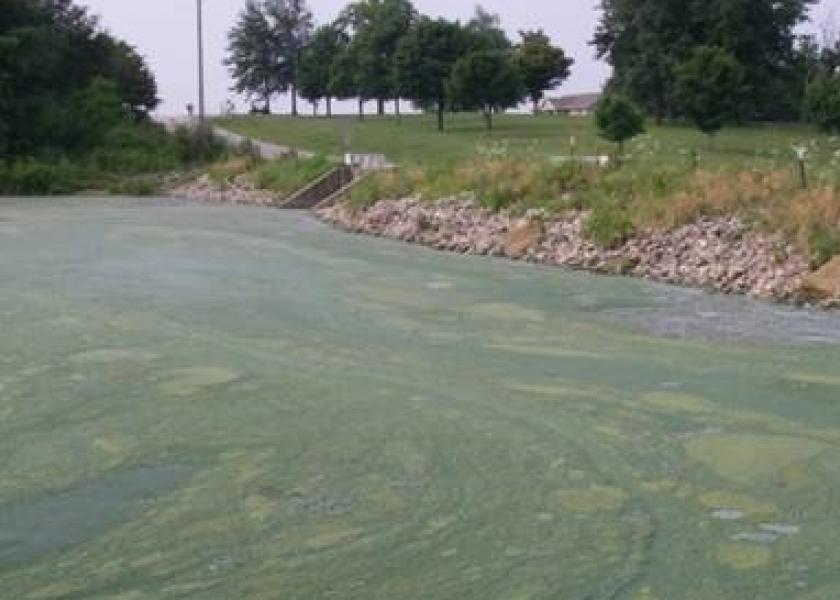Watch for Blue-Green Algae in Stock Ponds

The incidence of blue-green algae blooms has been increasing in the last 20 years, said Dr. Steve Ensley, clinical veterinary toxicologist with Kansas State University’s College of Veterinary Medicine. Some evidence suggests the blooms are driven by nitrogen and phosphorus runoff from agricultural practices used on cropland, or chemical runoff from cities and industrial practices, but neither speculation is backed by enough evidence to determine a cause. The blooms may occur on ponds from June through as late as October, and resemble what Dr. Ensley describes as spilled paint. In the right conditions, usually driven by the presence of nitrogen, phosphorus and rainfall, blue-green algae can produce toxins, he explained.
Mostly likely spurred by nitrogen and phosphorus runoff, rainfall and hot temperatures, blue-green algae, naturally present in most pasture water sources, can enter a rapid growth phase and produce toxins that can cause organ damage and death in livestock and humans.
Most common in the Midwest and Kansas is the microcystin. When consumed, the toxin can cause damage to the liver.
An animal affected by the liver toxin may become lethargic, avoid eating and may die within 24-48 hours following exposure. The animal may go down and liver failure can occur. Another indication of liver toxin is yellowing of the eyes.
Anabaena, or anatoxin, is a neurotoxin produced by blue-green algae. “The neurotoxins they produce can be very potent,” Dr. Ensley pointed out. One form of that toxin, fast-death factor, can kill a human or animal in a matter of minutes following exposure.
“It’s fairly acute, and if they consume enough, they may die right around the pond, or not make it too far from the water source,” Dr. Ensley said.
If a producer suspects a blue-green algae bloom on a pond, contact the Kansas State Veterinary Diagnostic Laboratory (KSVDL), Dr. Ensley said. He instructs producers to collect a 500 milliliter sample in a plastic bottle on the downwind side of the water source where a bloom is suspected. Where the algae isn’t concentrated, there may not be enough toxin to detect an issue. The sample should be sent to the lab chilled.
Methods of Control
To minimize the risk of blue-green algae toxicity, Dr. Ensley offered a few options. Solar aerators and dyes can help break up the blooms, but the implementation of buffer strips is the most widely used method of control throughout the Midwest. Buffer strips generally consist of grassland to minimize runoff from cropland to ponds.
He also pointed out that often, producers will suspect a blue-green algae bloom on the surface of tanks and waterers, but he said those generally won’t support algae growth. Wells are safe, too, due to limited sunlight.
“Waterers may look like they have moss on them,” Dr. Ensley explained. “They get dirty and the water may not look clean, but it’s rare to have an algae bloom in a water tank or water device.”
If a blue-green algae bloom is strongly suspected or confirmed, producers should move cattle off the pasture containing the affected water source to avoid organ damage and death loss. Contact the KSVDL at 785-532-5650, toll free at 1-866-512-5650, or at clientcare@vet.k-state.edu. Producers with animals needing immediate services should contact their local veterinarian, or may call the Veterinary Health Center Emergency Desk at 785-532-4100. For more information on testing, visit ksvdl.org.
Dr. Steve Ensley is a clinical veterinary toxicologist with the Kansas State Veterinary Diagnostic Lab (KSVDL) and College of Veterinary Medicine. Dr. Ensley’s interests are in clinical veterinary toxicology and applied veterinary toxicology research. Food animal veterinary toxicology is his passion.
For more on toxins and toxicosis in cattle, see these articles from BovineVetOnline:







